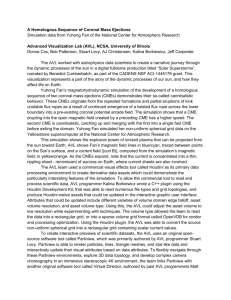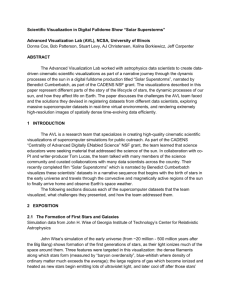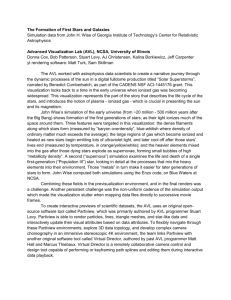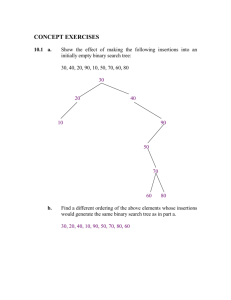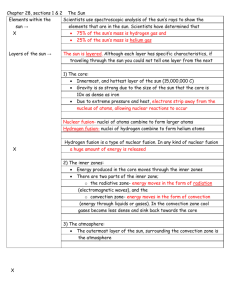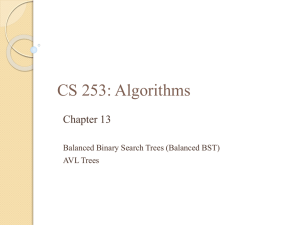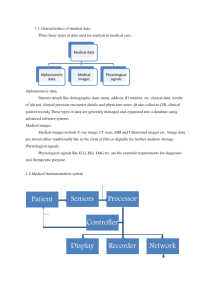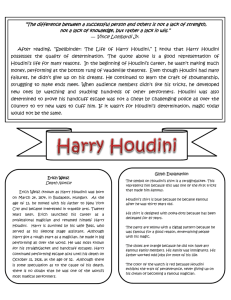Convection and Dynamo Action in a Sun
advertisement
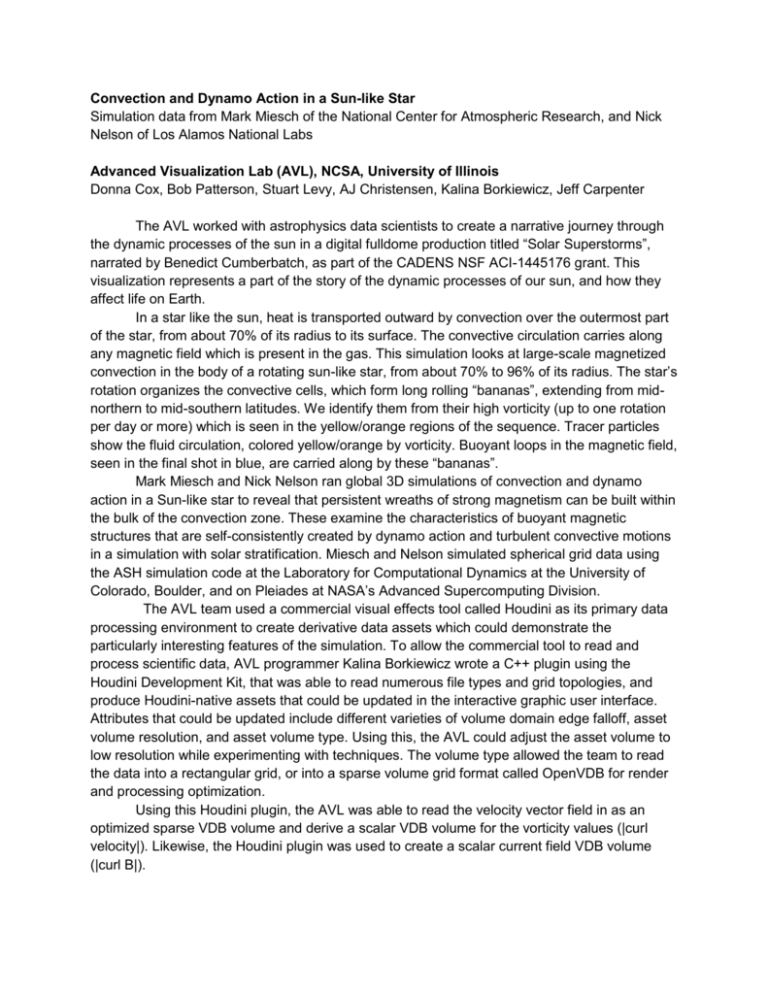
Convection and Dynamo Action in a Sun-like Star Simulation data from Mark Miesch of the National Center for Atmospheric Research, and Nick Nelson of Los Alamos National Labs Advanced Visualization Lab (AVL), NCSA, University of Illinois Donna Cox, Bob Patterson, Stuart Levy, AJ Christensen, Kalina Borkiewicz, Jeff Carpenter The AVL worked with astrophysics data scientists to create a narrative journey through the dynamic processes of the sun in a digital fulldome production titled “Solar Superstorms”, narrated by Benedict Cumberbatch, as part of the CADENS NSF ACI-1445176 grant. This visualization represents a part of the story of the dynamic processes of our sun, and how they affect life on Earth. In a star like the sun, heat is transported outward by convection over the outermost part of the star, from about 70% of its radius to its surface. The convective circulation carries along any magnetic field which is present in the gas. This simulation looks at large-scale magnetized convection in the body of a rotating sun-like star, from about 70% to 96% of its radius. The star’s rotation organizes the convective cells, which form long rolling “bananas”, extending from midnorthern to mid-southern latitudes. We identify them from their high vorticity (up to one rotation per day or more) which is seen in the yellow/orange regions of the sequence. Tracer particles show the fluid circulation, colored yellow/orange by vorticity. Buoyant loops in the magnetic field, seen in the final shot in blue, are carried along by these “bananas”. Mark Miesch and Nick Nelson ran global 3D simulations of convection and dynamo action in a Sun-like star to reveal that persistent wreaths of strong magnetism can be built within the bulk of the convection zone. These examine the characteristics of buoyant magnetic structures that are self-consistently created by dynamo action and turbulent convective motions in a simulation with solar stratification. Miesch and Nelson simulated spherical grid data using the ASH simulation code at the Laboratory for Computational Dynamics at the University of Colorado, Boulder, and on Pleiades at NASA’s Advanced Supercomputing Division. The AVL team used a commercial visual effects tool called Houdini as its primary data processing environment to create derivative data assets which could demonstrate the particularly interesting features of the simulation. To allow the commercial tool to read and process scientific data, AVL programmer Kalina Borkiewicz wrote a C++ plugin using the Houdini Development Kit, that was able to read numerous file types and grid topologies, and produce Houdini-native assets that could be updated in the interactive graphic user interface. Attributes that could be updated include different varieties of volume domain edge falloff, asset volume resolution, and asset volume type. Using this, the AVL could adjust the asset volume to low resolution while experimenting with techniques. The volume type allowed the team to read the data into a rectangular grid, or into a sparse volume grid format called OpenVDB for render and processing optimization. Using this Houdini plugin, the AVL was able to read the velocity vector field in as an optimized sparse VDB volume and derive a scalar VDB volume for the vorticity values (|curl velocity|). Likewise, the Houdini plugin was used to create a scalar current field VDB volume (|curl B|). Tracer particles were advected through the velocity volume to show the motion of the “bananas” and polar vortices. The tracer particles’ trajectories were reshaped by subtracting out the bulk rotation of the sun at a typical depth, so as to better show the local curvature of the circulation. Working with the scientists, AVL also advected particles in the magnetic volume in areas of high magnetic magnitude and regions identified by the scientists as likely candidates to illustrate a feature called buoyant loops, where waves of magnetic field rise toward the solar surface and create sunspots. These flow lines and magnetic field lines were then exported as geometric assets to be used in the pipeline. To create interactive previews of scientific datasets, the AVL uses an original opensource software tool called Partiview, which was primarily authored by AVL programmer Stuart Levy. To flexibly navigate through these Partiview environments, explore 3D data topology, and develop complex camera choreography in an immersive stereoscopic 4K environment, the team links Partiview with another original software tool called Virtual Director, authored by past AVL programmer Matt Hall and Marcus Thiebaux. Three separate shots were created using different assets. The first two focused on the vorticity data, and interactively displayed the time-evolving flowlines, as well as isosurfaces created in Houdini at varying thresholds. The third shot focused on the buoyant loops and interactively displayed the magnetic field lines and isosurface geometries. Houdini was also used to create a data-driven solar core, using temperature and fusion energy functions from a standard solar model. Radial and spatial algorithmic noise was added to give a sense of parallax and reduce occlusion of the far side of the convection data. Flow line and magnetic field line data was splatted into sparse VDB volumes. To fit the scene in the memory of the render nodes, AVL implemented a camera view frustum culling technique to remove lines outside the camera’s viewpoint, and a camera depth culling technique which allowed the team to split the lines into different depth layers of different resolutions. An external script also created a filtering process by which the team could remove lines that didn’t contribute significantly to tracing the important vortices across their lifetime. So that the shots could go above the surface of the sun, a sun surface asset was created using Matthias Rempel’s solar surface convection supercomputer simulation. Matthias’s data was interpolated in image compositing software, tiled to cover a larger percentage of the sun’s surface, and displaced based on intensity. Matthias’s data also included magnetic vectors, which were brought into Houdini as RGB values and then translated into small volumetric pointers on the surface of the sun. A halo was also put around the sun, mapped with imagery observed through NASA’s Solar Dynamics Observatory telescope. These many different datasets were rendered in several image layers from a unified camera path, and composited together using a commercial software tool called Nuke. Transitions past the solar surface utilized camera depth data and custom-drawn mattes to create an organic feeling between datasets.
